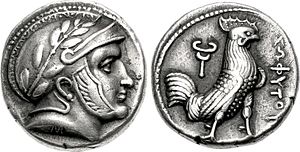Sophytes
| Sophytes ΣΩΦΥΤΟΥ |
|
|---|---|
| Ruler or Satrap | |

Coin of Sophytes.
Obv: Sophytes in profile with tight helmet and wreath. Rev: Cock standing to right, with caduceus, and legend in Greek: ΣΩΦΥΤΟΥ "Sophytes". |
|
| Reign | circa 300 BCE |
Sophytes, or Sopeites,Sophytos, is the name of a king or satrap who ruled circa 300 BCE in Bactria or in the northwestern Indian subcontinent, and whose exact identity is shrouded in mystery.
Sophytes is described in classical sources as a ruler in the Punjab region between the Hydraotes and the Hyphasis in the area of the Salt Range, who submitted to Alexander and was, thereby, permitted to retain his realms, probably as a vassal of Porus. He made a demonstration of four Indian dogs fighting a lion to Alexander. Sophytes is described as ruling along the Indus during the campaigns of Alexander the Great, in the Bibliotheca of Diodorus Siculus. Curtius also records an interview between the tall and handsome Sophytes and Alexander.
"Next he undertook a campaign against the cities under the rule of Sopeithes. These are exceedingly well-governed. All the functions of this state are directed toward the acquiring of good repute, and beauty is valued there more than anything. (...) Their king Sopeithes was strikingly handsome and tall beyond the rest, being over four cubits in height. He came out of his capital city and gave over himself and his kingdom to Alexander, but received it back through the kindness of the conqueror. Sopeithes with great goodwill feasted the whole army bountifully for several days." Bibliotheca of Diodorus Siculus Book 17
Possibly another Sophytes is also known from his abundant Greek coinage dated circa 300 BCE. Little is known about him and hypotheses are numerous: Sophytes may have been a Hellenistic satrap who replaced Stasanor in Bactria-Sogdiana, or may have ruled in a neighboring area; he may also have been a Satrap of Arachosia.
His rich and formal Greek coinage is however generally considered as Bactrian due to the distribution of the finds, and due to the coin types, of Athena with owl and eagle reverses, which are a clear continuation of the Attic coinage and the preceding anonymous Bactrian coin types derived from it. The coinage of Sophytes is often dated to 305-294 BCE
...
Wikipedia
